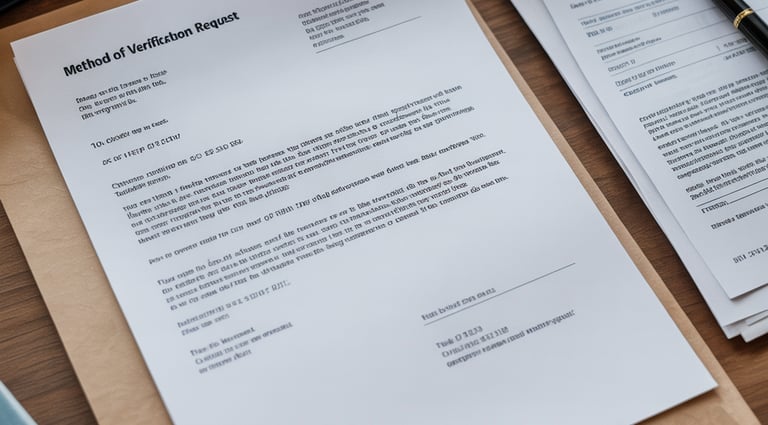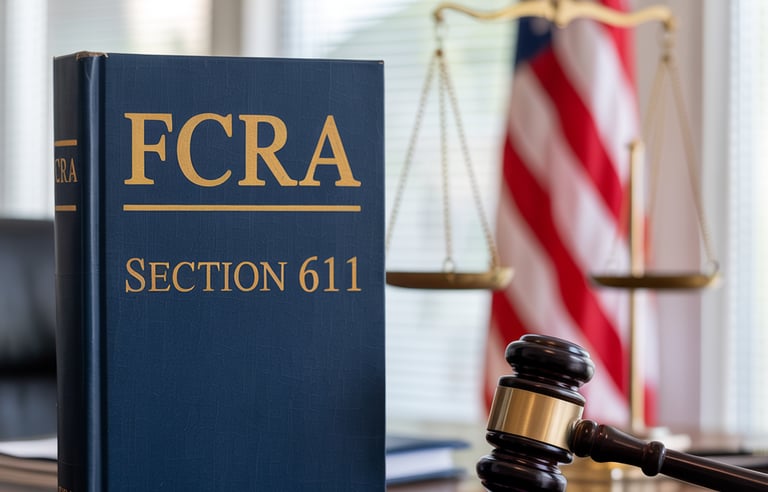"Method of Verification Dispute Letter: Your Complete 2026 Guide (+ Free Template)"
"The Method of Verification letter exposes weak credit bureau investigations. Get our free 611 dispute letter template and learn the escalation strategy that gets results."
CREDIT DESPUTE LETTERS
Jimmy Skirrts
10/13/202511 min read


Method of Verification Dispute Letter: Your Complete 2026 Guide (+ Free Template)
Updated: October 2025 • 11 min read
Look, I'm going to be straight with you. If you've disputed something on your credit report and the credit bureau came back saying "yeah, we verified it, it's accurate"—but you KNOW it's wrong—you're probably frustrated as hell right now.
I get it. You sent them a detailed letter. Maybe you included bank statements, payment records, or other proof. And they still said the negative item is "verified."
Here's the thing most people don't know: those credit bureaus probably never actually investigated your dispute the way you think they did.
That's where the Method of Verification dispute letter comes in. It's basically your way of saying "prove it" to the credit bureaus. And trust me, when you use this correctly, it works.
What Exactly Is a Method of Verification Letter?
Think of it this way: you disputed something, they said they checked it out and it's legit. Now you're firing back with "okay, show me EXACTLY how you verified this."
A Method of Verification letter (people also call it an MOV letter or 611 letter) demands that the credit bureau tell you:
Who did they contact?
What documents did they review?
When did this "investigation" happen?
How did they communicate with the creditor?
And here's the kicker—they legally have to tell you this information within 15 days. It's right there in Section 611 of the Fair Credit Reporting Act.
Why This Actually Works (The Secret They Don't Want You to Know)
Most credit bureau "investigations" go through this automated system called e-OSCAR. Basically, when you send them a detailed 2-page letter with all your proof, some employee just picks a 3-digit code from a dropdown menu and sends it to your creditor.
That's it. No human actually reviewed your documents. Nobody called anybody. They just checked if the account number exists in a database.
When you send a Method of Verification letter, you're forcing them to admit this. And guess what? When they can't show real proof of investigation, they have to delete the item or face legal trouble.
Hold Up—When Should You Actually Send This Letter?
Don't just fire off an MOV letter randomly. There's a specific time to use this weapon, and timing matters.
Send an MOV letter ONLY after:
✓ You already sent a regular dispute letter to the credit bureau
✓ You waited 30 days for them to respond
✓ They sent you a letter saying they "verified" the information
✓ You still know for a fact the information is wrong
Don't waste your time sending this if:
✗ You haven't disputed the item yet (do that first)
✗ They already deleted what you disputed (you won!)
✗ You're still waiting on your initial dispute response
✗ The information is actually correct (be honest with yourself)
Think of it like this: the regular dispute is your first shot. The Method of Verification letter is your follow-up punch when they block that first shot.
The Dirty Truth About How Credit Bureaus "Investigate" Disputes
Alright, let me pull back the curtain and show you what really happens when you dispute something.
The e-OSCAR System (Or: How Your Dispute Gets Butchered)
When your carefully written dispute letter arrives at Equifax, Experian, or TransUnion, here's what goes down:
Step 1: Some overworked employee opens your letter
Step 2: They skim it (maybe 30 seconds if you're lucky)
Step 3: They pick one of 29 pre-written codes that "sorta" matches your complaint
Step 4: That code gets entered into e-OSCAR
Step 5: The system auto-sends the code to your creditor
Step 6: Creditor checks their database, hits "confirm"
Step 7: Bureau marks it "verified" and closes your case
Your supporting documents? Probably never looked at.
Your detailed explanation? Reduced to "Code 001" or whatever.
Actual phone call to investigate? Yeah, right.
The 29 Magic Codes (That Replace Your Actual Words)
The e-OSCAR system only has 29 dispute codes. Here are some examples:
Code 001 = "Not his/hers" (for identity theft claims)
Code 010 = "Settlement accepted"
Code 023 = "Account closed by consumer"
Imagine you wrote 3 paragraphs explaining why a late payment is wrong, attached proof of on-time payment, and cited billing errors. All of that becomes "Code 012" in the system.
See the problem?
This is why Method of Verification letters are so powerful. You're forcing them to show their work, and their work is usually complete garbage.
Your Legal Rights (Yes, You Actually Have Them)
Section 611(a)(7) of the Fair Credit Reporting Act says:
"A consumer reporting agency shall provide to a consumer a description of the procedure used to determine the accuracy and completeness of the information... no later than 15 days after receiving a request."
In regular English: They must tell you how they verified it within 15 days, or they're breaking federal law.
Not 30 days. Not "when we get around to it." Fifteen days.
And if they don't? You can file complaints with the CFPB, report them to your state attorney general, or even sue them in small claims court.
They know this. That's why MOV letters get results.
Your Free Method of Verification Letter Template
Copy this, customize it with your info, and send it certified mail. Don't email it, don't use their online form—send actual mail with tracking.
[Your Full Name]
[Your Street Address]
[City, State, ZIP]
[Today's Date]
[Credit Bureau Name]
[Bureau Address]
Subject: Method of Verification Request - FCRA Section 611(a)(7)
Previous Report Reference: [insert their reference number]
To Whom It May Concern:
On [DATE], I received your response to my credit report dispute regarding the following item:
Creditor: [Name of Company]
Account Number: [Last 4 digits - ####]
Dispute Type: [Collection/Late Payment/Charge-off/etc.]
Your letter stated that this information was verified as accurate. However, I am certain this item is incorrect and should be removed from my credit report.
Under the Fair Credit Reporting Act, Section 611(a)(7), I am formally requesting a complete description of the investigation procedure you used to verify this disputed information.
Please provide me with:
The name and contact information of the specific person at [CREDITOR NAME] who verified this account
Copies of all documents you reviewed during your investigation
The exact method of communication used (phone, e-OSCAR system, mail, etc.)
The date(s) your investigation was conducted
The specific information the data furnisher provided to confirm accuracy
Any notes, correspondence, or internal documentation related to this verification
According to federal law, you must provide this information within 15 days of receiving this letter.
I am making this request because this inaccurate information is damaging my credit score and affecting my ability to obtain credit. If you cannot provide sufficient documentation proving a thorough investigation was conducted, I expect this item to be removed from my credit file immediately.
I have enclosed copies of my previous dispute letter, your response, and relevant supporting documents for your reference.
I expect your response within the legally required 15-day period.
Sincerely,
[Your Signature]
[Your Typed Name]
Enclosed:
Copy of original dispute letter
Copy of your verification response
Copy of credit report (disputed item circled)
[Any other proof you have]
How to Actually Mail This Thing (Don't Screw This Up)
Step 1: Make copies of EVERYTHING
Print 3 sets. One to send, one for your files, one backup copy in case you need to go to court later.
Step 2: Send it certified mail, return receipt requested
Yeah, it costs a few extra bucks. Do it anyway. This is your proof they got it.
Step 3: Use these addresses:
For Equifax:
P.O. Box 740256
Atlanta, GA 30374-0256
For Experian:
P.O. Box 4500
Allen, TX 75013
For TransUnion:
Consumer Dispute Center
P.O. Box 2000
Chester, PA 19016
Step 4: Track the timeline
Mark your calendar. Day 15 is the legal deadline. Day 20 is when you escalate if they don't respond.
What Happens Next? (Three Possible Outcomes)
Scenario A: They Cave and Delete It (This Is the Goal)
The credit bureau realizes they can't actually prove they investigated properly. They delete the item. You win.
What to do: Get it in writing. Check all three credit reports 30 days later to confirm deletion. Sometimes one bureau deletes it but the others don't—chase them all down.
Scenario B: They Send You Some Weak Documentation
They might send you something like "we contacted the creditor and they confirmed the account." That's vague BS.
What to do: Send another letter pointing out they didn't answer your specific questions. Ask again for the name of WHO they contacted, WHEN, and WHAT documents were reviewed. If they keep giving vague answers, escalate.
Scenario C: Radio Silence (They Ignore You)
This happens more than it should. They just don't respond within 15 days.
What to do: Now you escalate. File complaints. Send intent-to-sue letters. Make their life difficult. Details below.
When They Ignore You (Your Nuclear Options)
If 15 days pass and you get nothing, or they send you garbage that doesn't actually answer your questions, here's your battle plan:
Level 1: File a CFPB Complaint (Days 16-21)
Go to consumerfinance.gov/complaint and file a formal complaint against the credit bureau.
The Consumer Financial Protection Bureau is a government agency that actually has teeth. When they get a complaint, they forward it to the credit bureau, and that bureau HAS to respond within 30 days.
I've seen people get results within a week of filing a CFPB complaint. It's like suddenly someone important at the credit bureau notices you exist.
Level 2: State Attorney General + BBB (Days 21-25)
Pile it on. File complaints with:
Your state's Attorney General office
The Better Business Bureau
Multiple complaints from multiple agencies = more pressure. These companies care about complaint counts.
Level 3: Intent to Sue Letter (Days 25-30)
Send them a letter that says:
"You violated FCRA Section 611(a)(7) by failing to respond to my Method of Verification request within 15 days. Under FCRA Section 616, willful non-compliance can result in statutory damages. If this is not resolved within 10 days, I will file suit in [YOUR COUNTY] small claims court."
Use legal language. Make it clear you know your rights and you're not playing around.
Level 4: Actually Sue Them (Day 31+)
You've got two paths:
Option A - Small Claims Court
File yourself. Costs like $50-100. You can sue for:
Actual damages (harm to your finances)
Statutory damages (typically $100-1,000)
Sometimes attorney fees if you win
Option B - Hire a Consumer Rights Attorney
Find one at consumeradvocates.org. Many take these cases on contingency—meaning they only get paid if you win. No upfront costs.
Don't Make These Rookie Mistakes
I've seen people torpedo their own cases by screwing up these things:
❌ Mistake #1: Sending the MOV letter too soon
Wait for the "verified" response first. Don't jump the gun.
❌ Mistake #2: Using email or online dispute forms
Physical mail only. Certified. Tracked. Paper trail matters.
❌ Mistake #3: Making threats you won't follow through on
Don't threaten to sue if you're not actually willing to file. It makes you look like you're bluffing.
❌ Mistake #4: Disputing stuff that's actually accurate
Be real with yourself. If you DID miss that payment and it's reported correctly, this won't work.
❌ Mistake #5: Not keeping copies
If you end up in court, your documentation is everything. Keep. Everything.
❌ Mistake #6: Giving up after one try
Credit repair takes persistence. If they give you a weak response, push back harder.
❌ Mistake #7: Forgetting to follow up
Set phone reminders. Check your mailbox. Stay on top of deadlines.
Real Talk: How Often Does This Actually Work?
Let me be honest with you about success rates.
This strategy works best for:
✓ Collections that were already paid or aren't yours
✓ Late payments where you have proof you paid on time
✓ Identity theft situations
✓ Duplicate accounts showing up twice
✓ Old accounts past the 7-year reporting limit
✓ Accounts with sloppy record-keeping
This strategy usually fails for:
✗ Accurate recent late payments on current accounts
✗ Legit charge-offs from the last 2 years
✗ Bankruptcies that are properly documented
✗ Court judgments that are real and recent
✗ Anything that's 100% accurate and provable
Studies show that when consumers push back with MOV letters after the initial "verified" response, removal rates jump to 60-70% for legitimately questionable items.
But if the item is accurate and well-documented? Yeah, it's probably staying on your report.
MOV Letter vs. Other Dispute Letters (Which One When?)
People get confused about all these different letter types. Here's the simple breakdown:
The 609 Letter (Round 1)
What it does: Requests that bureaus verify information under FCRA Section 609
When to use: First time disputing any item
Goal: Force them to verify or delete
The 611/MOV Letter (Round 2) ← YOU ARE HERE
What it does: Demands proof of HOW they verified under FCRA Section 611
When to use: After they claim they verified something
Goal: Expose weak investigations and force deletion
The 623 Letter (Round 3 - Last Resort)
What it does: Goes directly to the creditor/data furnisher under Section 623
When to use: After 609 and 611 letters both fail
Goal: Make the creditor fix or remove the information
Think of it like a three-punch combo. Most people only throw the first punch and give up.
Real Questions People Ask Me About This
"Will this tank my credit score?"
Nope. Disputing items doesn't hurt your score. If items get removed, your score usually goes UP.
"Can I dispute multiple things in one letter?"
You can, but focus on 1-3 items max per letter. Too many disputes at once looks suspicious and gets less attention.
"What if they say the dispute is 'frivolous'?"
That means they think you're spamming them with the same dispute repeatedly without new info. Each dispute should add new evidence or reasoning.
"Do I need a lawyer for this?"
Not at first. Try it yourself. Only hire an attorney if you need to sue or the situation gets complex.
"How long until I see results?"
15 days for their response (by law). If they remove it, 30-60 days for it to actually come off your credit reports. If you have to escalate, add another 60-90 days.
"What if the account gets put back on my report later?"
They can only reinsert it if they have complete verification. They must notify you within 5 business days if they do this. If it pops back up without notice, that's another FCRA violation.
"Can I do this for medical debt?"
Absolutely. Medical collections are actually some of the easiest to get removed because the verification process is often sloppy.
The Bottom Line (Let's Wrap This Up)
Look, your credit report is basically your financial reputation in document form. And if there's wrong information on it, you're getting screwed every time you apply for a loan, apartment, or even some jobs.
The Method of Verification letter is your legal right to make the credit bureaus prove they actually did their job. Most of the time, they didn't. They just ran your dispute through an automated system and called it a day.
Here's what you need to remember:
→ Only use this AFTER your initial dispute gets "verified"
→ Send it certified mail so you have proof
→ They must respond within 15 days by law
→ If they can't prove real investigation, the item should be deleted
→ Don't give up if they ignore you—escalate aggressively
This isn't magic. It won't remove accurate negative information. But for items that are wrong or can't be properly verified? This letter is your best weapon.
Your Action Plan (What to Do Right Now)
Today:
Pull your credit reports from all three bureaus at annualcreditreport.com
Identify items that are incorrect or questionable
Make notes on why each item is wrong
This Week:
Send initial dispute letters for those items (if you haven't already)
Use certified mail, keep copies of everything
In 30-45 Days:
Check your mail for dispute responses
For any items they claim are "verified" but you know are wrong, prepare your MOV letters
Send those MOV letters via certified mail
In 60-75 Days:
Follow up on MOV letter responses
Escalate to CFPB if needed
Consider legal action for non-responsive bureaus
One More Thing Before You Go
The credit bureaus are banking on you giving up. They're counting on you getting one "verified" letter and just accepting it.
Don't be that person.
You have rights. Federal law is on your side. Use this Method of Verification letter to hold them accountable.
Your financial future is worth fighting for.
Legal Disclaimer: This guide provides educational information about credit disputes under the Fair Credit Reporting Act. I'm not a lawyer, and this isn't legal advice. Every situation is different, and outcomes vary. If you need specific legal guidance, talk to a consumer rights attorney. No guarantees on results—credit repair depends on your unique circumstances.
Got questions about your specific situation? Drop a comment below. Dealing with stubborn credit bureaus? Share your experience—let's help each other out.
💼 Take Control of What’s Reported About You
Most consumers never challenge the “verified” lies that ruin their credit. But you can. The Method of Verification Masterclass & Letters Pack shows you exactly how to demand proof, cite the law, and force credit bureaus to play fair.
Inside, you’ll get:
A full walk-through of how the Method of Verification works under the Fair Credit Reporting Act §611
Step-by-step video guidance
Ready-to-use letters that make the bureaus respond — or remove the account
👉 Get the Method of Verification Masterclass & Letters Pack today and start reclaiming the truth on your credit report.





